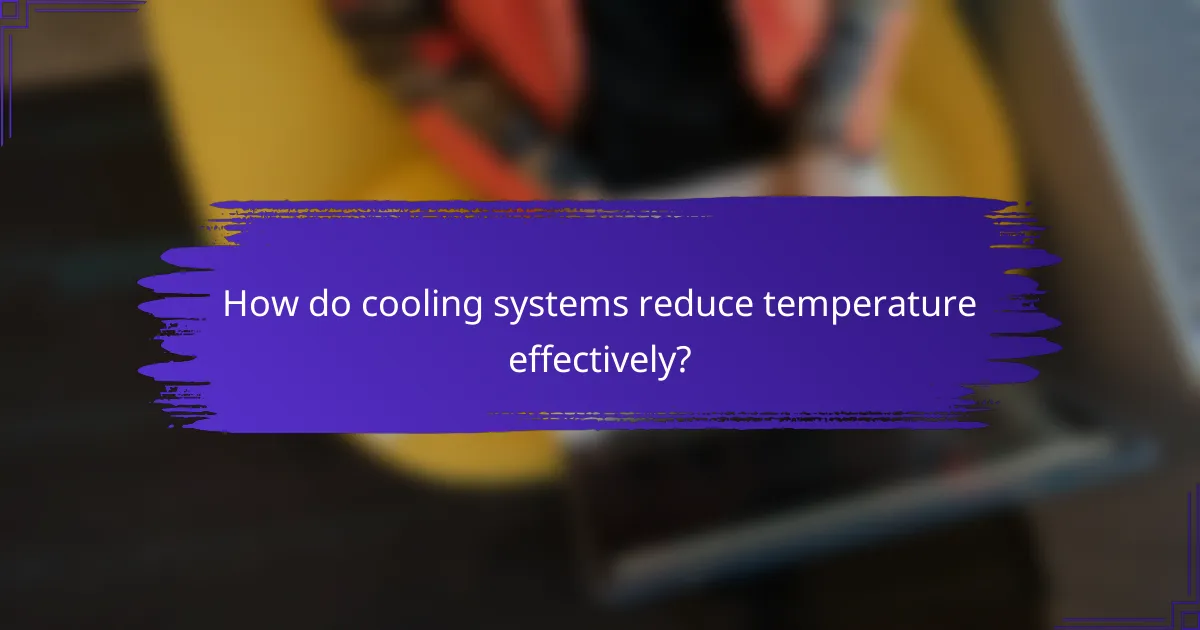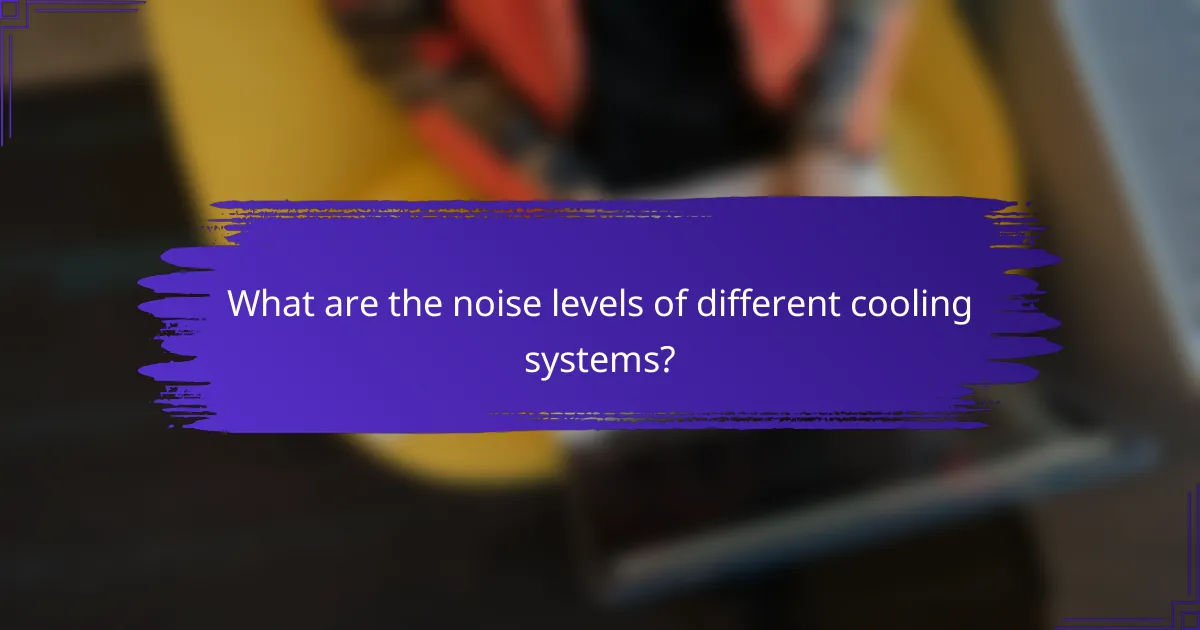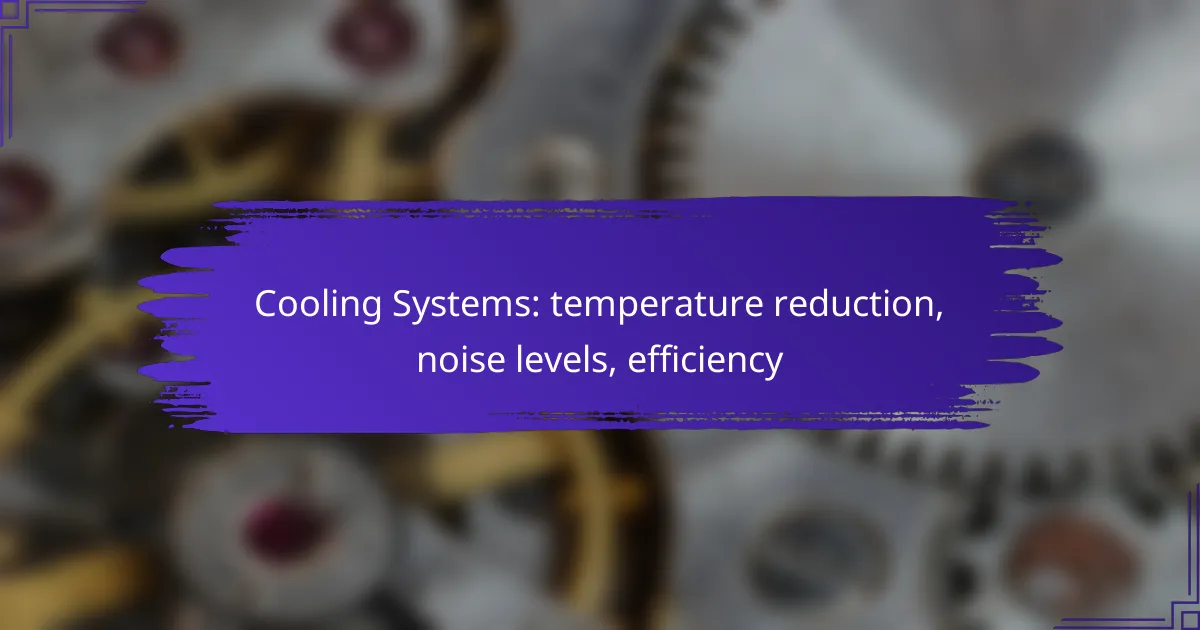Cooling systems are essential for maintaining comfortable indoor temperatures, particularly in residential settings. They operate by transferring heat away from a space, utilizing various technologies to optimize efficiency and performance. Additionally, noise levels can vary significantly among different types of systems, making it important to choose one that meets both cooling needs and sound preferences.

What are the best cooling systems for residential use in the UK?
The best cooling systems for residential use in the UK include central air conditioning systems, evaporative coolers, portable air conditioners, window units, and heat pumps. Each option has its own advantages and considerations regarding efficiency, noise levels, and installation requirements.
Central air conditioning systems
Central air conditioning systems are designed to cool an entire home using a network of ducts. They typically offer efficient temperature control and can reduce humidity levels effectively. However, installation can be costly and may require significant modifications to existing structures.
When considering a central system, look for energy-efficient models that meet UK regulations, such as those rated A or higher on the Energy Efficiency Scale. Regular maintenance is essential to ensure optimal performance and longevity.
Evaporative coolers
Evaporative coolers, also known as swamp coolers, use water evaporation to cool the air. They are particularly effective in dry climates and can be a cost-effective solution for cooling. However, their efficiency decreases in humid conditions, which can limit their effectiveness in some parts of the UK.
These systems consume less energy than traditional air conditioners, making them an environmentally friendly option. Ensure proper ventilation in your home to maximize their cooling potential.
Portable air conditioners
Portable air conditioners are versatile units that can be moved from room to room. They are ideal for renters or those who need temporary cooling solutions. While they are easy to install, they typically have lower cooling capacities compared to central systems.
When selecting a portable unit, consider its BTU rating to ensure it can adequately cool your space. Keep in mind that they may produce more noise than other systems, so check for models with lower decibel ratings for quieter operation.
Window units
Window air conditioning units are compact systems installed in a window frame. They are cost-effective and suitable for cooling single rooms. Installation is straightforward, but they can block natural light and views.
Choose a window unit with an appropriate BTU rating based on the size of the room. Regular cleaning of filters and coils is necessary to maintain efficiency and air quality.
Heat pumps
Heat pumps are versatile systems that can both heat and cool a home. They work by transferring heat from one place to another, making them energy-efficient options for year-round comfort. In the UK, air-source heat pumps are commonly used for residential cooling.
When considering a heat pump, look for models that comply with UK energy efficiency standards. They may require a higher upfront investment but can lead to significant savings on energy bills over time.

How do cooling systems reduce temperature effectively?
Cooling systems reduce temperature by transferring heat away from a designated area, utilizing various methods to enhance efficiency and performance. Key components such as heat exchangers, refrigerants, and airflow management play crucial roles in this process.
Heat exchange process
The heat exchange process is fundamental to cooling systems, where heat is absorbed from the environment and dissipated elsewhere. This typically occurs in heat exchangers, which can be air-cooled or water-cooled, depending on the system design.
In air-cooled systems, ambient air passes over coils containing a refrigerant, allowing heat to transfer from the refrigerant to the air. Water-cooled systems, on the other hand, use water to absorb heat, which is then expelled through cooling towers. The choice between these systems often depends on factors like installation space and local climate.
Refrigerant circulation
Refrigerant circulation is vital for maintaining the cooling effect in a system. The refrigerant, a fluid with a low boiling point, absorbs heat as it evaporates in the evaporator coil and releases heat when it condenses in the condenser coil.
Effective circulation ensures that the refrigerant moves continuously through the system, maintaining optimal pressure and temperature levels. Regular maintenance is essential to prevent leaks and ensure efficient operation, as even minor refrigerant loss can significantly reduce cooling capacity.
Airflow management
Airflow management directly impacts the efficiency of cooling systems. Proper airflow ensures that cool air is distributed evenly throughout the space while preventing hot spots. This can be achieved through strategic placement of vents, fans, and ducts.
Using variable speed fans can enhance airflow control, allowing systems to adjust based on cooling demand. It’s important to avoid obstructions around air intake and exhaust areas to maintain optimal airflow. Regular cleaning of filters and ducts is also recommended to ensure efficient operation and reduce energy consumption.

What are the noise levels of different cooling systems?
Noise levels of cooling systems vary significantly based on the type and design. Understanding these levels helps in selecting a system that balances cooling efficiency with acceptable sound output for your environment.
Central air conditioning noise levels
Central air conditioning systems typically operate at noise levels ranging from 60 to 70 decibels (dB). These units are designed to be installed outside, which helps minimize indoor noise. However, the sound can still be noticeable, especially if the outdoor unit is placed close to living areas.
When choosing a central air system, look for models with a lower decibel rating for quieter operation. Additionally, consider sound insulation options for ducts to further reduce noise transmission indoors.
Portable air conditioner noise ratings
Portable air conditioners generally produce noise levels between 50 and 70 dB, depending on the model and its cooling capacity. While they offer flexibility in placement, their noise can be disruptive, especially in small rooms.
To minimize noise, select a portable unit with a lower dB rating and consider using it during times when noise is less likely to be an issue, such as during the day when activities are more active.
Window unit sound output
Window air conditioning units usually operate at noise levels of 50 to 60 dB. These units are often quieter than portable models but can still generate noticeable sound, particularly when the compressor kicks in.
For quieter operation, look for window units labeled as “quiet” or those with inverter technology, which can adjust their speed and reduce noise during operation. Proper installation and sealing can also help minimize sound leakage into the room.

How efficient are various cooling systems?
Cooling systems vary significantly in efficiency, impacting energy consumption and operating costs. Understanding their efficiency ratings helps in selecting the right system for your needs.
Energy Efficiency Ratio (EER)
The Energy Efficiency Ratio (EER) measures the cooling output of a system divided by its energy consumption at a specific temperature, typically 35°C. A higher EER indicates a more efficient cooling system, which can lead to lower electricity bills.
For residential air conditioning units, an EER of around 10 to 12 is considered average, while units with an EER above 12 are generally more efficient. When choosing a system, look for models with higher EER ratings to maximize energy savings.
Seasonal Energy Efficiency Ratio (SEER)
The Seasonal Energy Efficiency Ratio (SEER) evaluates the cooling efficiency of air conditioning systems over an entire cooling season, factoring in varying temperatures. This metric provides a more realistic assessment of energy use compared to EER.
In the United States, the minimum SEER rating for new residential units is set at 14, while higher-end models can achieve SEER ratings of 20 or more. Selecting a system with a higher SEER can significantly reduce energy costs during peak cooling months.
Comparative efficiency of heat pumps
Heat pumps are versatile systems that provide both heating and cooling, often with higher efficiency than traditional air conditioning units. Their efficiency is typically measured using the Heating Seasonal Performance Factor (HSPF) for heating and SEER for cooling.
Many modern heat pumps achieve SEER ratings between 15 and 25, making them a cost-effective choice for year-round climate control. When considering a heat pump, evaluate both its cooling and heating efficiencies to determine overall performance and potential savings.

What factors should be considered when choosing a cooling system?
When selecting a cooling system, consider temperature reduction capabilities, noise levels, and overall efficiency. Each of these factors plays a crucial role in ensuring that the system meets your specific needs and operates effectively in your environment.
Temperature reduction
Temperature reduction is a primary function of any cooling system. Evaluate the system’s cooling capacity, typically measured in BTUs or kilowatts, to ensure it can handle the heat load of the space. For residential systems, a capacity range of 5,000 to 20,000 BTUs is common, depending on the size of the area being cooled.
Consider the climate in your region as well. In hotter climates, a more powerful system may be necessary to achieve comfortable indoor temperatures. Additionally, look for systems with variable speed options, which can adjust cooling output based on current conditions, enhancing efficiency.
Noise levels
Noise levels are an important consideration, especially in residential or office settings where quiet operation is preferred. Most cooling systems have a noise rating measured in decibels (dB). Aim for systems that operate below 60 dB for a quieter experience.
Inverter systems tend to be quieter than traditional units because they adjust their speed gradually rather than turning on and off abruptly. If noise is a concern, consider models with sound-dampening features or those designed specifically for low-noise operation.
Efficiency
Efficiency is crucial for reducing energy costs and environmental impact. Look for the Energy Efficiency Ratio (EER) or Seasonal Energy Efficiency Ratio (SEER) ratings, which indicate how effectively a cooling system uses electricity. Higher ratings generally mean better efficiency.
For residential systems, a SEER rating of 14 or higher is often recommended for optimal efficiency. Additionally, consider systems that utilize eco-friendly refrigerants, which can further enhance performance while minimizing environmental harm.
